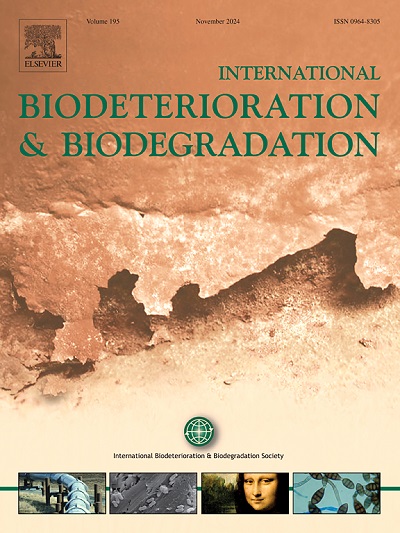A laboratory approach to mitigating ammonia in broiler litter material with chemical additives
IF 4.1
2区 环境科学与生态学
Q2 BIOTECHNOLOGY & APPLIED MICROBIOLOGY
International Biodeterioration & Biodegradation
Pub Date : 2025-06-27
DOI:10.1016/j.ibiod.2025.106157
引用次数: 0
Abstract
Broiler litter is a major source of ammonia (NH3) emissions in poultry production systems, negatively impacting both animal welfare and worker health. This study aimed to evaluate the effectiveness of chemical additives in reducing NH3 volatilization and to identify the optimal application dosage for practical use. The research was conducted in two phases. In Phase I, four additives — aluminum sulfate (Al2(SO4)3), clinoptilolite zeolite, sodium bisulfate (NaHSO4), and magnesium sulfate (MgSO4) — were applied to spent broiler litter. Among them, NaHSO4 demonstrated the highest NH3 reduction efficiency (76.7 %). In Phase II, varying dosages of sodium bisulfate (2.5 %, 5 %, 7.5 %, and 10 % w/w) were tested, with the 7.5 % application achieving the highest mitigation performance (95.0 %). Additionally, sodium bisulfate treatment improved the ammonium nitrogen content of the litter, enhancing its agronomic value as a potential organic fertilizer. The findings highlight sodium bisulfate as a promising strategy for reducing NH3 emissions, offering both environmental and economic benefits. This approach may enhance air quality in poultry houses. It can also increase the nutrient value of litter, contributing to sustainable crop production. The laboratory-scale results offer a strong basis for future field studies. These studies are needed to validate the method under commercial production conditions.

用化学添加剂减少肉鸡窝料中氨的实验室方法
肉鸡产仔是家禽生产系统中氨(NH3)排放的主要来源,对动物福利和工人健康产生负面影响。本研究旨在评价化学添加剂减少NH3挥发的效果,并确定实际应用的最佳用量。研究分两个阶段进行。在第一阶段,将硫酸铝(Al2(SO4)3)、沸石沸石、硫酸氢钠(NaHSO4)和硫酸镁(MgSO4) 4种添加剂应用于废肉鸡窝产仔。其中NaHSO4的NH3还原效率最高(76.7%)。在第二阶段,测试了不同剂量的硫酸氢钠(2.5%、5%、7.5%和10% w/w),其中7.5%的应用达到了最高的缓解性能(95.0%)。此外,硫酸钠处理提高了凋落物的铵态氮含量,提高了其作为潜在有机肥的农艺价值。研究结果强调,硫酸氢钠是一种很有前途的减少NH3排放的策略,既能带来环境效益,又能带来经济效益。这种方法可以改善禽舍的空气质量。它还可以增加凋落物的营养价值,有助于可持续作物生产。实验室规模的结果为未来的实地研究提供了坚实的基础。这些研究需要在商业生产条件下验证该方法。
本文章由计算机程序翻译,如有差异,请以英文原文为准。
求助全文
约1分钟内获得全文
求助全文
来源期刊
CiteScore
9.60
自引率
10.40%
发文量
107
审稿时长
21 days
期刊介绍:
International Biodeterioration and Biodegradation publishes original research papers and reviews on the biological causes of deterioration or degradation.

 求助内容:
求助内容: 应助结果提醒方式:
应助结果提醒方式:


